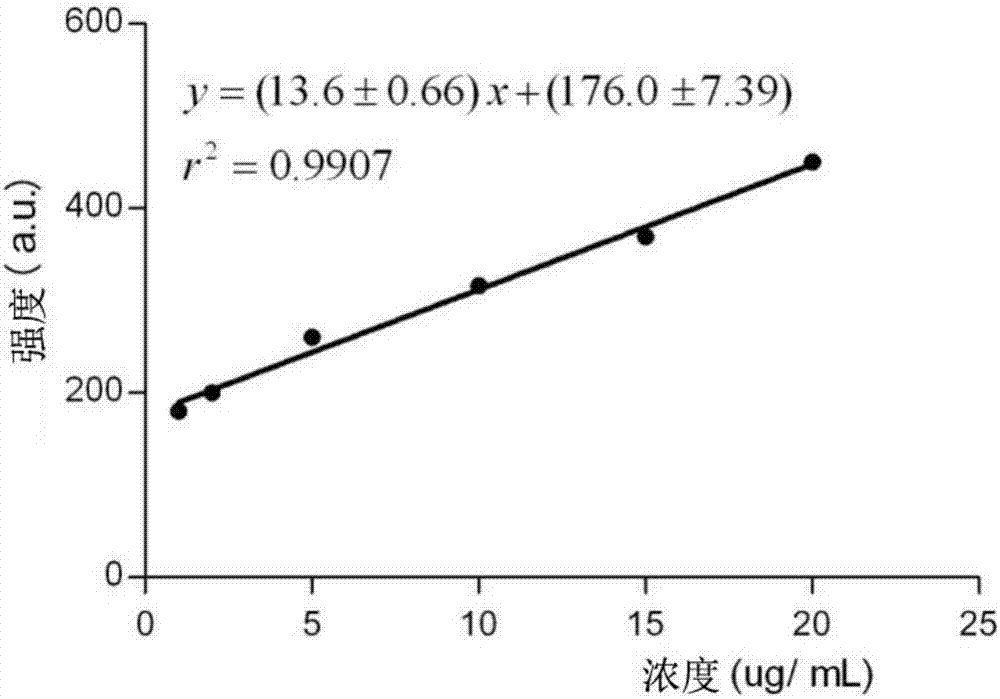Method used for detecting 2,4-dichlorophenoxyacetic acid residue in fruits and vegetables
A dichlorophenoxyacetic acid and detection method technology, which is applied in the direction of measuring devices, instruments, and material analysis through optical means, can solve the problems of cumbersome operation, low analysis sensitivity, and inappropriate on-site detection and analysis of a large number of samples
- Summary
- Abstract
- Description
- Claims
- Application Information
AI Technical Summary
Problems solved by technology
Method used
Image
Examples
Embodiment 1
[0027] Configure 2,4-D methanol aqueous solution with a concentration of 20, 15, 10, 5, 2, 1 μg / mL, mix it with the gold colloid in step 1 at a ratio of 1:5, and scan the Raman spectrum to obtain the concentration gradients Surface-enhanced Raman spectrum of the solution; 2,4-D characteristic peaks are 718, 838, 890, 1159, 1256, 1308, 1445, 1591cm -1 ; and take the concentration as the abscissa, and take the characteristic peak 838cm -1 The peak intensity is the ordinate, and a standard curve is made for quantification; such as figure 1 , figure 2 As shown, the linear equation of the standard curve obtained is y=(13.6±0.66)x+(176.0±7.39), the correlation coefficient is 0.9907, and the linearity is good, which can be used to determine the 2,4-D content in the sample.
Embodiment 2
[0029] Accurately weigh 10.0g of the vegetable sample, fully break the sample with a sample masher or a homogenizer, then put the mashed vegetables into a centrifuge tube, add 10mL of 0.01mol / L NaOH solution, shake and extract for 2-10min, 8000r Centrifuge at a speed of 5 min / min, take the supernatant, then add NaOH solution, shake and extract for 2-10 min, repeat the above operation, combine the extracts, adjust the pH to 3.0 with 1mol / L hydrochloric acid, pass through a 0.45um filter membrane, and extract all The liquid passes through the activated solid-phase extraction column at a flow rate of 3mL / min. After the sample is loaded, it is rinsed with 3mL aqueous hydrochloric acid solution. 3 OH elution, repeated 4 times, combined eluent, blown to near dryness with nitrogen, fixed solution with methanol aqueous solution to 2mL, used for surface-enhanced Raman spectrum detection, made three parallel samples, and the analysis results are shown in Table 1; It can be seen that the...
PUM
 Login to View More
Login to View More Abstract
Description
Claims
Application Information
 Login to View More
Login to View More - R&D
- Intellectual Property
- Life Sciences
- Materials
- Tech Scout
- Unparalleled Data Quality
- Higher Quality Content
- 60% Fewer Hallucinations
Browse by: Latest US Patents, China's latest patents, Technical Efficacy Thesaurus, Application Domain, Technology Topic, Popular Technical Reports.
© 2025 PatSnap. All rights reserved.Legal|Privacy policy|Modern Slavery Act Transparency Statement|Sitemap|About US| Contact US: help@patsnap.com



